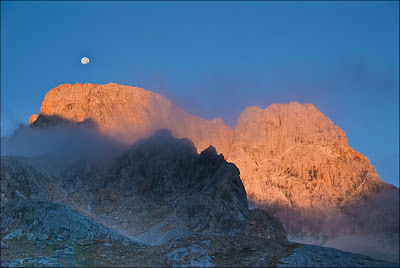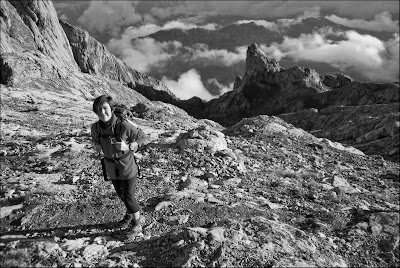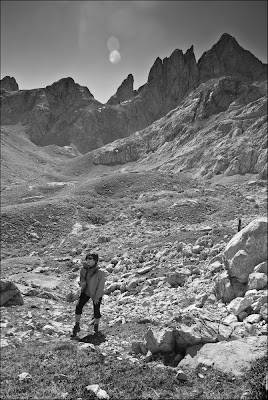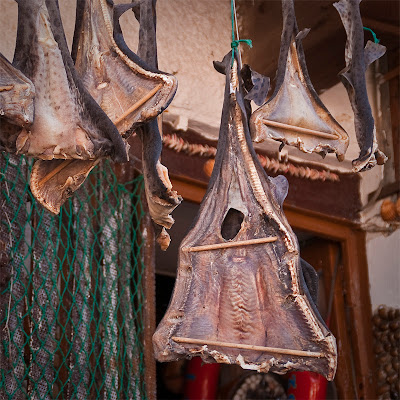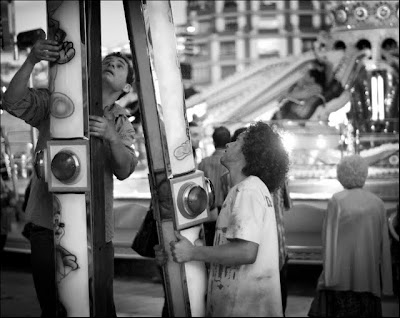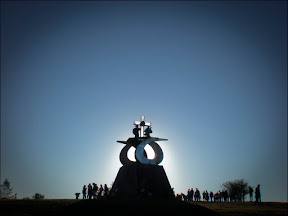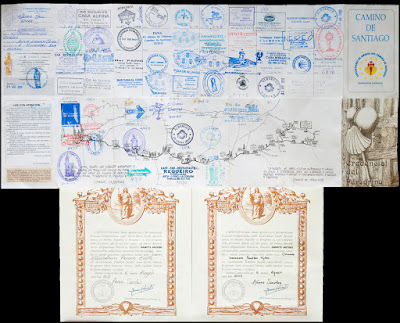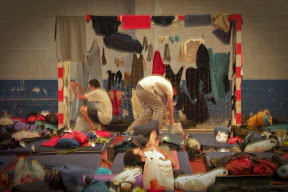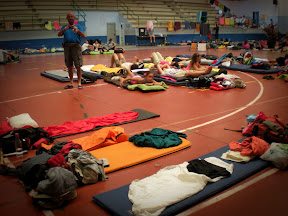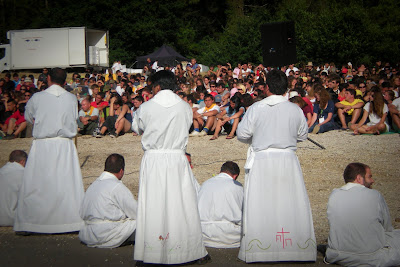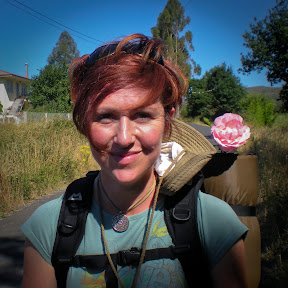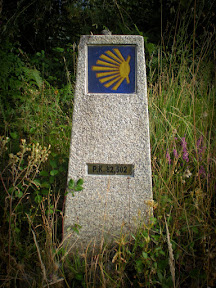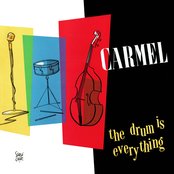En castellano
I was shaken awake by someone. It was still dark, Julio and Liz had not been sleeping particularly well (the symphony of the wild boars, they said… ¡vaya jabalís!) I suppose in a sportshall with a hundred and some other folk you’re bound to get some world-class snorage. Julio in particular didn’t want to hang around. I don’t blame him, it wasn’t the most pleasant place to lie awake. Liz took my head torch and proceded to blind first herself and then me while getting her gear together. We tried not to giggle, not wanting to wake the others up. We weren’t the first to move, there were a dozen or so head torches bobbing up and down in the dark.
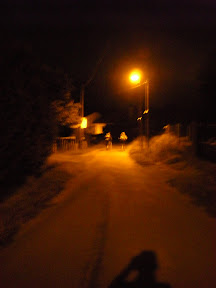
Early? Stupid O'clock!
It wasn’t until we emerged from the fug of a couple of hundred pilgrims that I noticed it was still pitch black outside. Then I looked at my watch.
It was 4:45am.
Julio was keen to get ahead of ‘los chinos’ but this seemed to be taking it a bit too far. Still, the clouds cleared and we had a fine view of the stars as we walked. I turned off my head torch and let my eyes become accustomed to the dark, the moon was half full and provided plenty of light to walk by. Until we passed a group of early risers with head torches on who insisted on looking at the faces of everyone coming past i.e. us. And then until Julio decied to shine his torch in my face too… a conspiracy. By the time my eyes had dark adapted properly once again the clouds had come over and astronomy time was over.
We crossed and re crossed a main road, the path rising away from it to crest a hill in a straight line before descending to meet the road again. In among the trees the darkness was total. We passed a couple of people in sleeping bags at the side of the path, lowering our voices so as not to wake them.
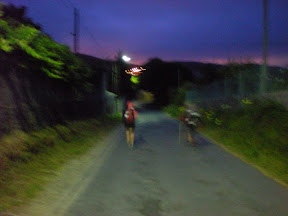
Always darkest before the dawn? No, it's a little bit lighter than before...
A strange series of poles and lights signalled the airport. No planes this early but there were a few helicopters lit up on their landing pads. Even at this early hour we were not alone. As it got a little lighter we passed a bar, just open by the look of it, and decided to stop for breakfast. It was 7am. Julio was keen to keep going… he didn’t say so, but he hum’d and hah’d and looked at his watch… getting to the next albergue ahead of the Koreans had become a little bit of an obsession. We didn’t really mind about the Koreans but we really needed coffee. It’s one thing to walk all day after breakfast… but another thing entirely to walk a long way beforehand.
The bar had indeed just opened. A woman took our order for coffees and pastries while seeming half asleep. We ate and drank and watched other groups arrive, all of them stopping for breakfast. Most of them, I would guess, would be continuing on to Santiago that day. We were going to stop in Monte de Gozo. At the front of the queue.
It was humid, and our path rose steadily. It began to drizzle a little bit (the only rain we had that week). We passed TV studios and repeater towers, so we thought we must be just about there but the albergue stubbornly refused to appear on the long straight road. A can of coke from a vending machine chained to the gate of a garden centre gave us a bit more energy and we rounded the first corner for what seemed like ages to see a sign pointing to the albergue.
It was still a good kilometre away mind. But Julio was off, determined not to let “los chinos” get the better of him.
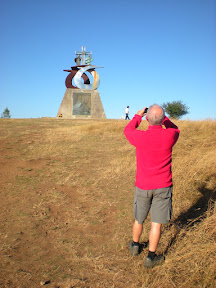
Looking for "los chinos"
Monte de Gozo means mount of joy. It is so called because it’s the first point on the camino from which you can see Santiago. You can’t see much of the city, certainly not more than a couple of spires of the cathedral. At the high point there’s a sculpture which was put up to celebrate JPII coming to Santiago in 1989. He didn’t do the camino, the wimp (albeit a 70 year-old wimp at the time). The sculpture has four large metal bas reliefs on each side, one of them looked like the pope about to push saint Jimmy over a railing, there’s modern art for you.
Below the chapel and the sculpture is the albergue. It’s part of a holiday complex which appears to be modelled on a POW camp, or maybe that’s the effect of the depressingly grey Galician granite.
We were the first to arrive. Julio had to restrain himself from doing a little jig, that’ll show those chinese, he said. We asked what time the albergue opened, one o’clock, they said. I got my book out, it was 8:15am.
Because it was a holiday complex, there were shops and cafes so we took turns to go for second breakfast (I am a firm believer in that hobbit tradition, especially when you get up at ungodly o’clock). Other pilgrims arrived and the queue of rucksacks grew. No Chinese or Koreans appeared.

The default position at Monte de Gozo... resting in the sun.
The albergue is enormous, four or six buildings, 400 places (800 are available if necessary) so we could have arrived at 9pm and got a place but after the rather longer day than planned the previous day, it was a real pleasure to not walk. Liz and I had our books to read and the sun came out making it a very pleasant morning.
We dumped our stuff in our assigned room and showered and washed clothes. We left them baking in the sun while we went to a local restaurant for a 7 euro menu of the day. The rest of the day involved doing very very little, wandering down to the cafe and back, having a beer, people watching, in short, relaxing.
Castellano
Alguien me sacudió para despertarme. Todavía estaba oscuro, Julio y Liz no habían dormido bien (gracias a la sinfonía de los jabalís) supongo que en un polideportivo con unos ciento y algo otros sea normal tener los que roncan de fama mundial. Julio, sobre todo, no quiso permanecer así, yo estaba de acuerdo con el, no estaba el lugar mas bonito para estar sin poder dormir. Liz cogió mi linterna frontal con que se deslumbró primero y luego a mi mientras ella estaba recogiendo la mochila, intentamos contener las risitas para evitar que despertemos la gente. No éramos los primeros despiertos, había mas o menos una docena de linternas frontales que se movían en el oscuro.
Una vez que salimos del aire sofocante del polideportivo me fijé que todavía estaba oscura, miré a mi reloj.
Eran las 4:45.
Julio tenía ganas de llegar antes de “los chinos” pero esto parece un poco exagerado. Pues bueno, el cielo se despejó y nos permitía una vista de las estrellas mientras caminábamos. Apagué mi linterna y daba a mis ojos tiempo para estar acostumbrados a la oscuridad, había media luna que daba suficiente luz para andar. Hasta que pasamos por un grupo de madrugadores que llevaba linternas frontales y que miraba a las caras de todos que lo pasaban, y hasta que Julio me alumbró la linterna suya… ¡qué conspiración! Cuando mis ojos estaban acostumbrados a la oscuridad, estaba nublado y la hora de astronomía se acabó.
Cruzábamos unas veces una carretera, el camino subía desde el asfalto para llegar a la cumbre de una colina en una linea recta y después bajaba hasta la carretera otra vez. Entre los arboles la oscuridad estaba total. Pasamos unas personas que dormían en sacos al lado del camino, hablábamos en voces bajas para no despertarlos.
Pasábamos por unos postes y luces del aeropuerto, no había aviones tan temprano pero había unos helicópteros iluminados en los plataformas de aterrizaje. Aun que era temprano no caminábamos solos. Un poco antes del amanecer encontramos un bar que parecía abierto, decidimos desayunar. Eran las 7h, Julio tenía ganas de continuar, no nos dijo así pero nos indicaba hesitación y miraba al reloj, llegar al próximo albergue antes de los coreanos se había convertido en una pequeña manía. Nos daba igual sobre los coreanos pero nos faltaba el café. Caminar todo el día después del desayuno es una cosa, caminar mucho antes del desayuno es otra cosa en total.
El bar acababa de abrir, la camarera nos atendió medio dormida. Desayunábamos con cafe y bollería y miraban mas grupos llegando. Todos pararon para desayunar, la mayoría supongo iría a Santiago aquel día. Ibamos a parar en Monte de Gozo, en la cabeza de la cola.
Había humedad, el camino subía constantemente, empezó lloviznar un poco (la única lluvia de la semana). Pasamos por unos edificios y repetidores de televisión, por eso pensábamos que casi habíamos llegado pero el albergue no apareció en la carretera larga y recta. Compramos una lata de coca-cola de una maquina expendedora encadenado a una verja de un centro de jardinería, esta nos dio un poco más energía. Al doblar la primera esquina después de un buen rato, vimos un señal que nos indicaba al albergue.
Nos quedaba un kilometro largo, Julio marchó, estaba decidido a quedar encima de “los chinos”.
Monte de Gozo se llama así porque es el primer lugar en el camino desde donde es posible ver la ciudad de Santiago. No es posible ver mucho de la ciudad, desde luego no mucho más que las agujas de la catedral. En el punto más alto hay una escultura que se construyeron para conmemorar la visita del papa (JPII) a Santiago en 1989. El no hizo el camino, que flojo (aunque un flojo de 70 años en aquel momento). La escultura tiene cuatro bajorrelieves, uno parecía como si el papa estuviera al punto de empujar al Santo Jaime por encima de la barandilla de un balcón, eso es el arte moderno.
El albergue esta debajo de la capilla y la escultura, forma una parte de un complejo de vacaciones que parece basado en un campo de detención, quizás por el efecto del granito lúgubre de Galicia.
Llegamos primeros. Julio parecía si quisiera hacer aspavientos –vencimos a los chinos, el dijo. Preguntamos a que hora se abriría el albergue, a la una dijeron, saque mi libro, eran las 8:15.
Porque era un complejo de vacaciones había tiendas y cafés, nos turnamos ir a tomar el “segundo desayuno” (soy un partidario de la tradición de los hobbits, sobre todo cuanto se levanta a una hora intempestiva). Mas peregrinos llegaban y la cola de las mochilas se extendía. No apareció ningún chino ni coreano.
El albergue es enorme, tiene cuatro o seis edificios, sitio para 400 (800 si sea necesario) entonces pudiésemos haber llegado a las 21h y cogiésemos sitio, pero tras el día anterior mas larga que habíamos esperado era un placer no caminar. Teníamos nuestros libros y salió el sol que hacía una mañana agradable.
Dejamos las mochilas en el dormitorio nuestro, nos duchamos y lavamos la ropa que dejamos secando en el sol cuando salimos a comer en un restaurante muy cerca, comimos el menú de 7€. El resto del día hicimos muy poco, dimos unas vueltas, tomamos unas cervezas, miramos a la gente, en resumen, descansamos.



